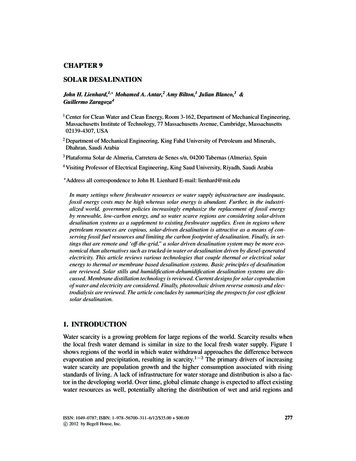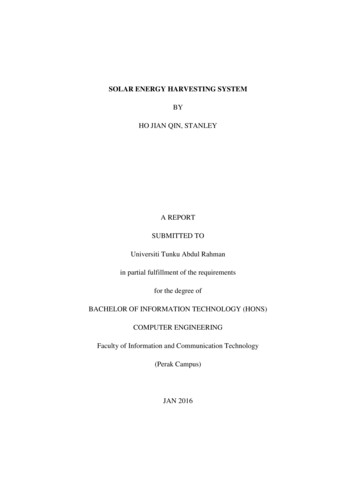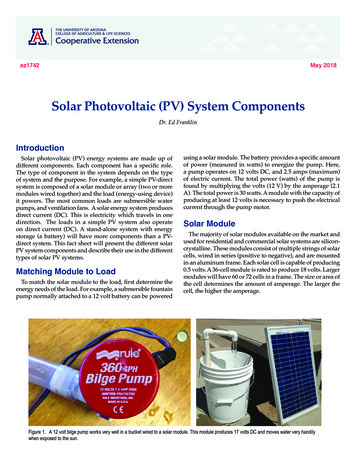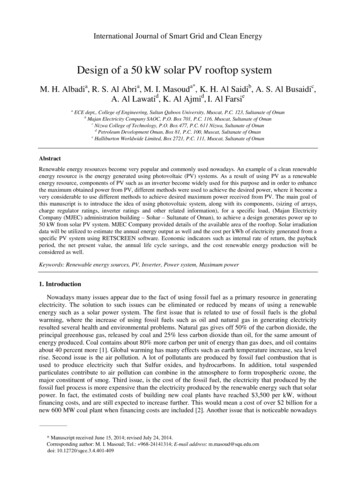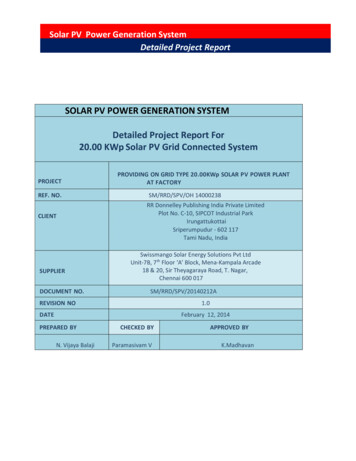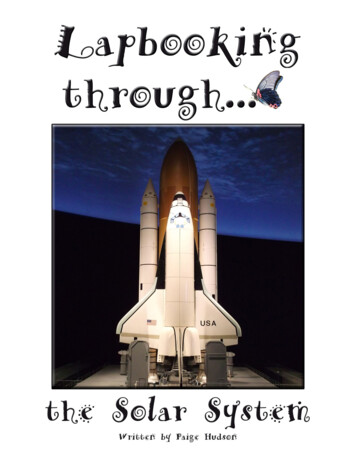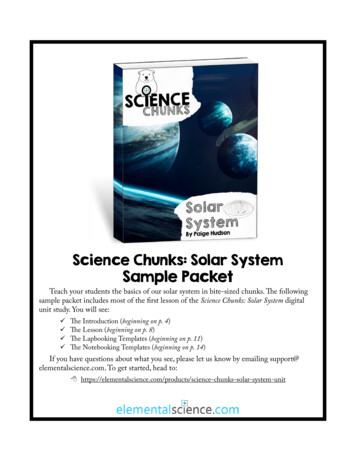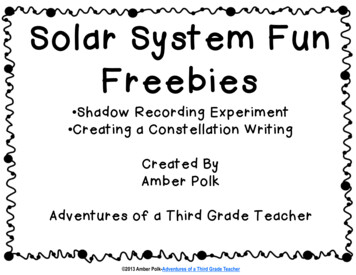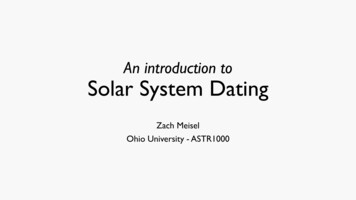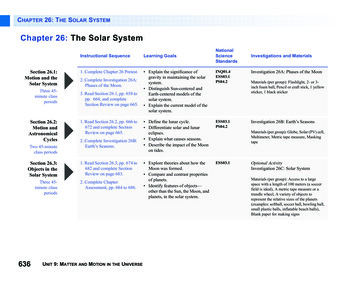
Transcription
CHAPTER 26: THE SOLAR SYSTEMChapter 26: The Solar SystemSection 26.1:Motion and theSolar SystemThree 45minute classperiodsSection 26.2:Motion andAstronomicalCyclesTwo 45-minuteclass periodsLearning Goals1. Complete Chapter 26 Pretest. Explain the significance ofgravity in maintaining the solarsystem. Distinguish Sun-centered andEarth-centered models of thesolar system. Explain the current model of thesolar system.INQ01.4ESS03.1PS04.2Investigation 26A: Phases of the Moon Define the lunar cycle. Differentiate solar and lunareclipses. Explain what causes seasons. Describe the impact of the Moonon tides.ESS03.1PS04.2Investigation 26B: Earth’s Seasons Explore theories about how theMoon was formed. Compare and contrast propertiesof planets. Identify features of objects—other than the Sun, the Moon, andplanets, in the solar system.ESS03.12. Complete Investigation 26A:Phases of the Moon.3. Read Section 26.1, pp. 658 topp. 664, and completeSection Review on page 665.1. Read Section 26.2, pp. 666 to672 and complete SectionReview on page 665.2. Complete Investigation 26B:Earth’s Seasons.Section 26.3:Objects in theSolar System1. Read Section 26.3, pp. 674 to682 and complete SectionReview on page 683.Three 45minute classperiods2. Complete ChapterAssessment, pp. 684 to 686.636NationalScienceStandardsInstructional SequenceUNIT 9: MATTER AND MOTION IN THE UNIVERSEInvestigations and MaterialsMaterials (per group): Flashlight, 2- or 3inch foam ball, Pencil or craft stick, 1 yellowsticker, 1 black stickerMaterials (per group): Globe, Solar (PV) cell,Multimeter, Metric tape measure, MaskingtapeOptional ActivityInvestigation 26C: Solar SystemMaterials (per group): Access to a largespace with a length of 100 meters (a soccerfield is ideal), A metric tape measure or atrundle wheel, A variety of objects torepresent the relative sizes of the planets(examples: softball, soccer ball, bowling ball,small plastic balls, inflatable beach balls),Blank paper for making signs
CHAPTER 26 RESOURCESAssessment ToolsChapter 26 PretestSection 26.1 ReviewProgram ResourcesSkill and Practice Worksheets Astronomical Units, GravityProblems, Universal Gravitation,Nicolaus Copernicus Biography,Galileo Galilei Biography,Johannes Kepler Biography,Measuring the Moon’s DiameterTechnology ResourcesTeaching Illustrations The Solar System Sizes of Planets Relative to the SunLesson OrganizerTeaching Illustrations Distance from Earth to the Sun Moon Phases Earth’s Rotation and RevolutionLiterature SelectionsEarth: Our Planet in Space by Seymour SimonSimon is a former teacher and an award-winningauthor of more than 200 books, including manyothers befitting the topics addressed throughout thisunit. This book offers clear explanations of therelationships between Earth, the Sun, and the Moonand contains excellent color photographs.Teaching Illustrations Terrestrial Planets Gas LawsNightWatch: A Practical Guide to Viewing theUniverse by Terence DicksonNightWatch, the third edition is easily consideredone of the best field guides for beginningastronomers. Includes discussions on lightpollution, buying a telescope and binoculars,pronunciation of stars and constellations andphotographs.CPO Website—www.cposcience.com Equipment Setup Videos Science Content Videos Simulations Presentation SlidesGraphic Organizers 26A The Solar SystemSection 26.2 ReviewStandardized TestPracticeSection 26.3 ReviewChapter 26 AssessmentExamView Test Bank Multiple Choice Multi-formatSkill and Practice Worksheets Benjamin Banneker BiographyGraphic Organizers 26B The Lunar CycleSkill and Practice Worksheets Touring the Solar SystemAstronomy Connection: WhatHappened to Pluto?Chapter Activity The Distance from Earth to the SunExploring Our Solar System by Sally Ride andTam O’ShaughnessyAnother tour of the solar system, but this time it isnavigated by astronaut Sally Ride and educatorTam O’Shaughnessy. This is a well-written bookwith straightforward language that is filled withfacts and full colored photographs.637
CHAPTER 26: THE SOLAR SYSTEMInvestigation 26A: Phases of the MoonWhy does the Moon appear to change shape over the course of a month? In thisinvestigation, students will model the lunar cycle and figure out if there really is a “darkside” of the Moon.lunar cycle - the cycle of change in the appearance of theMoon due to the positions of Earth, the Moon, and the Sun.Key QuestionWhat causes the lunar cycle?ObjectivesStudents will: Describe the lunar cycle.Use a Sun-Moon-Earth model to explain the appearance of the Moon at different phases.Justify the description of the Moon’s far side.Setup1.One class period is needed to complete the investigation.2.Students work in small groups of three to five.3.A 1-watt LED flashlight with an adjustable beam works best in this investigation, but youcan also get satisfactory results with a bell-shaped utility lamp with a 25-watt bulb. Theseinexpensive lamps can be found at hardware stores.4.The white stickers (1-inch diameter) commonly used to mark prices on yard sale items maybe used in this activity. Use permanent markers to color them yellow and black. The stickerscan be found at office supply stores.MaterialsSafetyEach group should have the following: 638Flashlight2- or 3-inch foam ballPencil or craft stick 1 yellow sticker1 black stickerUNIT 9: MATTER AND MOTION IN THE UNIVERSEStudents should observe general laboratory safetyprocedures while completing Investigation 26A.
INVESTIGATION 26A: PHASES OF THE MOONInvestigation26APhases of the Moon26A Phases of the MoonWhat causes the lunar cycle?Why does the Moon appear to change shape over thecourse of a month? In this investigation you will model thelunar cycle and figure out if there really is a “dark side of theMoon.”Aa.Materials Phases of the MoonFlashlight2- or 3-inch foam ballPencil or craft stick1 Yellow sticker1 Black stickerCInvestigation1. Place a foam ball on a pencil or stick. This ballrepresents the Moon.2. Have another student hold a flashlight. The flashlightrepresents the Sun. Your head represents Earth.Think about itInvestigation3. Hold the ball slightly above your head, at arm’s lengthfrom your face. Stand about one meter from theflashlight, which is held at the same level as the ball.When was the last time you noticed the Moon? Describe or draw its shape.D3You have probably noticed that the Moon doesn’t look the same every time you see shownit. But in Figure 2. Face the ball at eachposition.have you ever thought about how it changes over the course of a month? In the chartbelow, draw the shapes of the Moon in the order that you think you would see them.Two5. Foreach position, indicate how much of theviews have been drawn to help you get started. How would you represent a “full Moon?”ball is dark and how much is illuminated, inthe graphic below. Use a pencil to show theshaded region. Leave the illuminated partwhite.4B5678926APhases of the MoonThinking about what you observedIf you could see the Sun-Moon-Earth system from above, you would see that half of the Moon isalmost always illuminated by sunlight.4. Observe the Moon in each of the positionsb.26AModel the lunar cycleFInvestigation26AIn order to determine whether or not the Moon rotates, you will mark one side of your Moonmodel with a yellow sticker. You need to stand outside the Sun-Earth-Moon model, at point 1,2, 3, or 4 in the diagram below, in order to detect rotation. If the sticker always faces the sameclassroom wall, you will know the moon doesn’t rotate. If the sticker faces different walls atdifferent times, you will know that the Moon does, in fact, rotate.101. Place a yellow sticker on one side of thestyrofoam ball. This sticker represents theside of the ball that we can see from Earth.Place a black sticker on the opposite side.Make a hypothesisYou’ve spent some time thinking about what the lunar cycle looks like. Now, can you explainwhy the Moon appears to change shape?67a.Create a hypothesis to explain why the Moon appears to change shape. Why doesn’t itlook the same every time you see it?b.What variable or variables do you think affect the way the Moon appears?A170Phases of the MoonTest your ideas8B9C10D11E12F2. You will play the role of an observer inspace, outside of the Sun/Moon/Earthsystem. Choose position 1, 2, or 3 as shownHere on Earth, the fraction of the Moon that is illuminated appears to change as the Moonin the diagram at right.revolves around Earth.3. Have another member of your group playa. When you see a full Moon in the sky, at which position (A–H) is the Moon in its orbit?the role of the Sun as before.4. A third group member should hold theG b. At whichH position (A–H) would the Moon not be visible from Earth?Moon model with the yellow sticker facinghim/her. This student will model the lunarc. Reread the hypothesis you wrote in step 2. If the activity changed your thinking aboutcycle just as you did in part 3.why the Moon appears to change shape, revise your statement. Otherwise, write “nochange.”5. Observe the yellow sticker as the Moonmoves in its orbit. Notice whether or not the yellow sticker faces the same classroomd. If you hold the ball at eye-level, do the Moon phases appear as they do in real life? What wall throughout the activity.does that tell you about the Moon’s actual orbit around Earth?6. Watch the lunar cycle model one more time. This time, watch the black sticker.Notice whether or not the black sticker remains in the dark throughout the cycle.Is there a “dark side” of the Moon?7. Switch roles within your group until everyone has observed the lunar cycle again.You may have noticed that the Moon has somedarker areas (known as maria) on its surface.Thinking about what you observedBecause the maria are always in the same locationa. Does the Moon rotate? How do you know?when we view the Moon, we know that we alwayssee the same side of the Moon from Earth. Thinkback to your lunar cycle model as you answer theb. If so, how many complete rotations do you think the Moon makes during one orbit ofquestions below.Earth?171a. If we always see one side of the Moon, does that mean that there is another side of theMoon that is always dark?c. Is one side of the Moon forever in darkness? Why or why not?b. Why is it that we always see the same side of the Moon? Do you think the Moon rotates asit orbits Earth? Why or why not?d. Which is a better name for the side of the Moon we cannot see from Earth:The dark side of the Moon, or172The far side of the Moon?Why?13EG173639
CHAPTER 26: THE SOLAR SYSTEMTeaching Investigation 26AA Think about itMany people enjoy looking at the night sky to see the Moon and stars. Is this something you enjoy?Students share answers.When was the last time you noticed the Moon? What did it look like?Students share what they observed as they looked at the Moon.Use the space provided on your handout to draw what you observed when you last looked at theMoon.Allow time for students to complete drawings.Look at the drawings three or four of your classmates made. Are they all identical? You haveprobably noticed that the Moon doesn’t look the same every time you see it. But have you everthought about how it changes over the course of a month? In the chart provided, draw the shapesof the Moon in the order that you think you would see them over the course of a month. Twoviews have been drawn to help you get started.Students may or may not have prior knowledge of the lunar cycle. Make it clear to studentsthat it is okay to make their best guess, as they are not expected to know all about the Moonstages. The goal is to be able to make comparisons between what students think before doingthe investigation and their impressions after the activity. Encourage students to discuss theirideas with group members as they sketch how the shape of the Moon changes over time.How would you represent a “full” Moon?The full Moon would be an all-white circle. No part of it is shaded.B Make a hypothesisThe lunar cycle is the cycle of change in the appearance of the Moon due to the positions of Earth,the Moon, and the Sun. This is what you have represented as you sketched the changes in theMoon’s shape over a one-month period. Now that you have spent some time thinking about whatthe lunar cycle looks like, are you able to explain why the Moon appears to change shape? Discuss this question with members of your group. Then write a hypothesis to express your thoughts.Allow students to share their opinions. Lead a discussion to steer students toward understanding that the Moon appears to change shape as the angle formed by Earth, the Moon, and theSun changes.What factor or factors do you think might affect the way the Moon appears? Talk it over with yourgroup members.The way the Moon appears depends on the position of the Moon relative to Earth and the Sun.Some common misconceptions about the variables that influence the appearance of the Moon640UNIT 9: MATTER AND MOTION IN THE UNIVERSE
INVESTIGATION 26A: PHASES OF THE MOONinclude the following: Earth’s shadow, the Sun’s shadow, Earth’s position in its orbit aroundthe Sun, and the season of the year.C Model the lunar cycleIn this part of the investigation, you will model the lunar cycle. Place a foam ball on a pencil orstick. This ball represents the Moon. Have another student hold a flashlight. The flashlight represents the Sun. Your head represents Earth.Hold the ball slightly above your head, at arm’s length from your face. Stand about 1 m from theflashlight, which is held at the same level as the ball. Observe the Moon in each of the positionsshown in Figure 2. Face the ball at each position. For each position, indicate how much of the ballis dark and how much is illuminated. Use a pencil to show the shaded region. Leave the illuminated part white.Explain to students that they are representing eight evenly spaced days within the approximately month-long (29.5-day) lunar cycle. Earth spins on its axis each day so that at som
CPO Website—www.cposcience.com Equipment Setup Videos Science Content Videos Simulations Presentation Slides Section 26.2 Review Standardized Test Practice Skill and Practice Worksheets Benjamin Banneker Biography Graphic Organizers 26B The Lunar Cycle Teaching Illustrations Distance from Earth to the Sun Moon .

